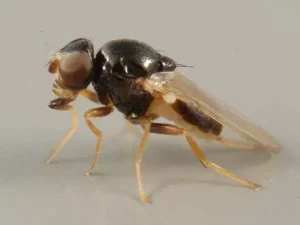Gnat Control
 Not just a water and sewer utility, BWD also has powers to provide gnat abatement and to maintain flood control infrastructure around the Ram’s Hill community. Responsibilities include setting out gnat traps on golf courses and brush/flow management around flood berms. These activities are funded thru County tax assessments on benefited parcels.
Not just a water and sewer utility, BWD also has powers to provide gnat abatement and to maintain flood control infrastructure around the Ram’s Hill community. Responsibilities include setting out gnat traps on golf courses and brush/flow management around flood berms. These activities are funded thru County tax assessments on benefited parcels.
What is a Gnat?
A Gnat is any of many species of tiny flying insects. They are prevalent in the Southern United States, primarily in parts of California and Arizona. The adult eye gnats are non-biting insects. To produce their eggs, eye gnats feed on the protein found in body secretions such as mucus from the eyes and nose. In large numbers, their persistent buzzing around human and animal eyes can be an annoyance to both people and animals.
What time of year are eye gnats the biggest problem in San Diego County?
Eye gnats can be active anytime the temperature is over 70 degrees with the most activity occurring when temperatures get into the 90’s. This usually means the peak of activity will be during the warmer summer months
You can prevent eye gnats around your home.
The best way to reduce a pest such as eye gnats it to reduce area in which they breed. Remove leaf litter, weeds, grass clippings and flowers before they decay. Reducing the amount of moisture or irrigation and keeping the surface soil dry will help reduce egg laying and larval survival.
You can create your own eye gnat trap at home using a variety of methods:
*Ingredients:
- 2 Raw eggs
- 1 gallon of tap water
- 3 or 4 one liter bottles
Procedure:
- Mix 2 raw eggs with 1 gallon of tap water.
- Pour bait into Bottle and fill approximately 2-3 inches from the bottom of the container.
- Hang trap at a 4-foot height level, either on trees or fence posts. Traps should be set up if possible at least 30-40 feet away from area used by residents, such as entry doors, patio, deck, and children’s play area.
- Change bait every week for eye gnats and every 10 days for flies, or when dead bugs fully cover the surface area
*This will fill about 3-4 one-liter bottles.
Ingredients:
- Eggs
- 1 liter or 1 gallon plastic containers
- Knife or ¾ drill bit
Procedure
- In an empty plastic container, crack 4 eggs/ gallon and fill with water.
- Cut or drill 3 to 4 holes on upper 1/3 of container.
- Hang traps 3-4 feet off the ground and fill with bait.
- Traps should be set up if possible at 30-40 feet away from areas used by residents, such as entry doors, patio, deck and children's play area.
- Check and refill at least once a week
Some other options for gnat trap baits
- Vinegar, sugar, and dish soap: Mix equal parts vinegar and soap in a bowl, then add a few tablespoons of sugar. The gnats will be attracted to the sugar and vinegar, and the dish soap will trap them.
- Apple cider vinegar: Gnats are attracted to the strong, fruity smell of apple cider vinegar. Mix a few tablespoons of apple cider vinegar and a few drop of dish soap in a bowl.
- Red wine and dish soap: Mix stale wine and a few dashes of dish soap in a glass or jar.
- Rotting fruit: Place pieces of overripe fruit in a bowl, cover it with plastic wrap, and poke small holes in the plastic with a toothpick; the gnats will be attracted to the rotting fruit, crawl through the holes, and become trapped inside the bowl unable to escape
- Candle and water: Fill bowl with water, set candle inside and light, turn lights off.
- Baking soda and vinegar: Mix equal parts baking soda and vinegar to create a paste. Apply the paste to areas where gnats are present, like sink drains or garbage disposals. Let it sit for a few minutes, then rinse with hot water
- Bleach: Mix ½ cup bleach with a gallon of water (in a bowl), then slowly pour it down the drain and flush with hot water.
Flypaper ribbons: You can hang sticky flypaper ribbons to catch gnats, but be careful where you put them.



